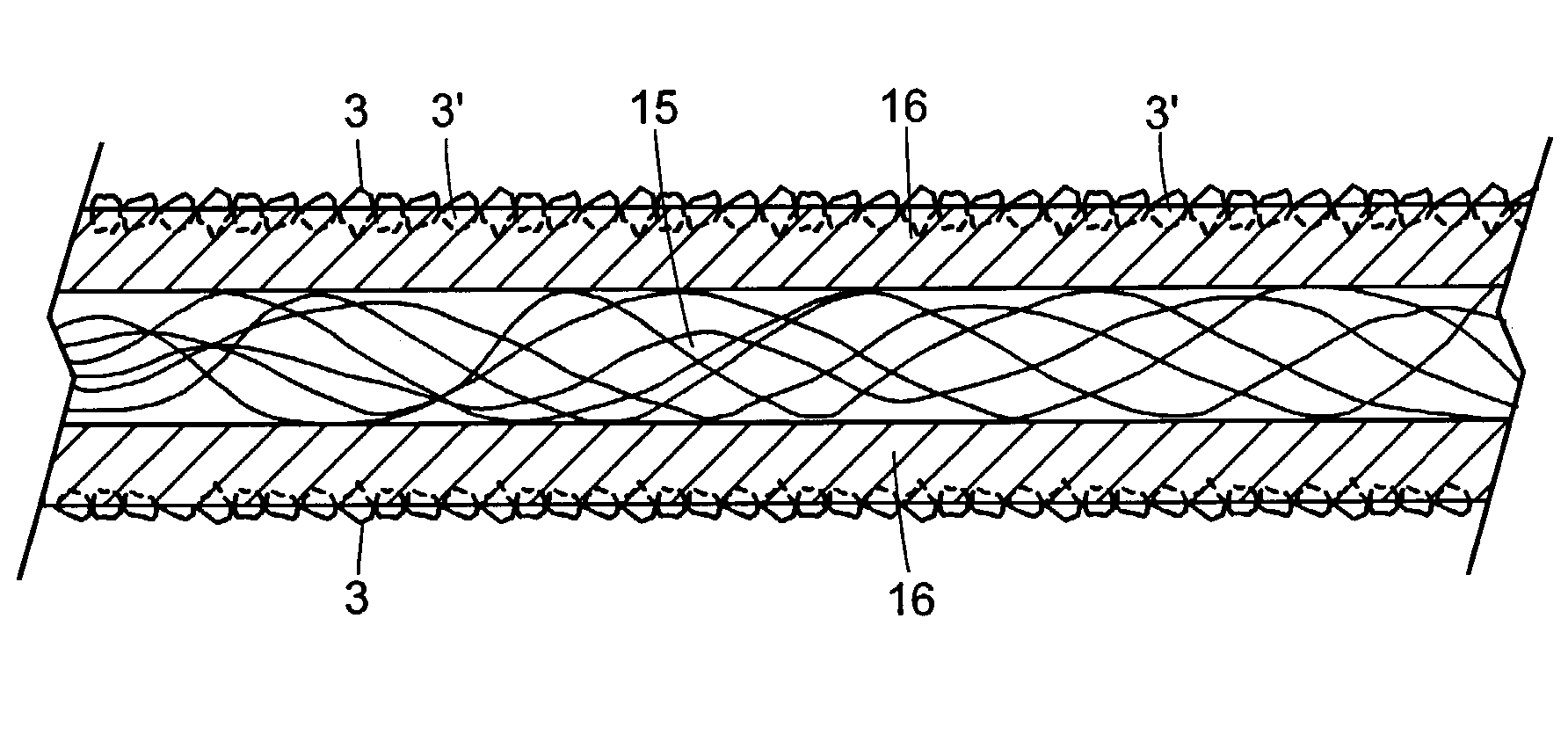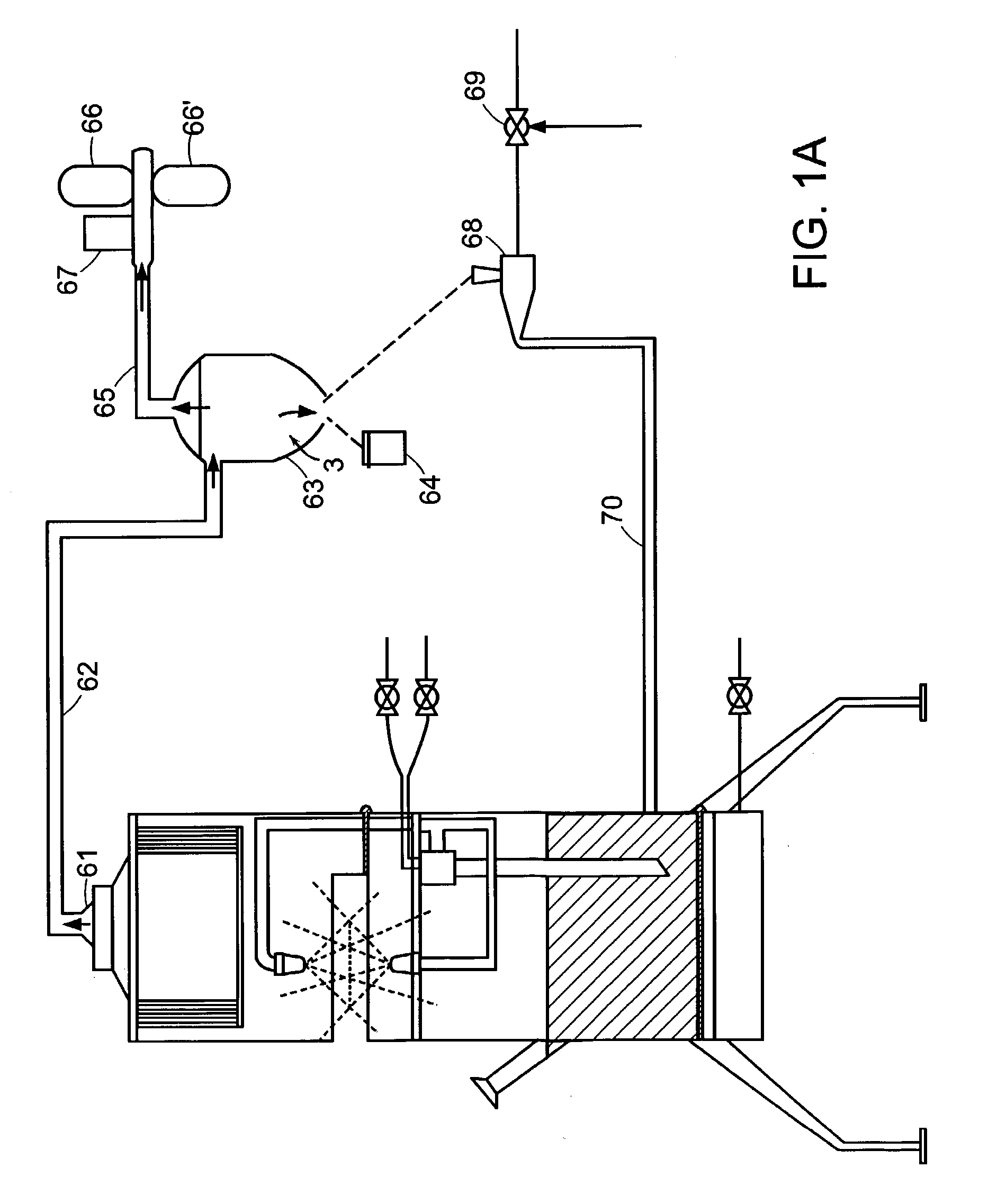[0039]During flossing, at the outset, the imbedded particulate
abrasive overcoating functions as a “soft”
abrasive version of an oral-type
sandpaper removing, disrupting and / or controlling biofilms. Essentially the
first pass through an
interproximal space by the imbedded particulate, overcoated, multifilament dental floss results in a gentle “
sandpaper” abrasive effect on the biofilms present, which effect is eventually followed by dissolving and / or breaking up of the waxed
coating containing the particulate abrasive which is present on the multifilament strands. In another embodiment of the invention, insoluble base
coating materials are used. These do not readily release from the multifilaments during flossing, and when impregnated with particulate abrasive, create a soft abrasive-type dental floss
sandpaper, which is very effective in gently removing, disrupting and / or controlling
biofilm throughout the use-life of the dental floss.
[0046]Surprisingly, the particulate abrasive overcoating imbedded in the base
coating on the multifilament dental floss of the present invention exhibits unexpected gentleness along with lower than expected abrasivity which, for purposes of the present invention, allows more abrasive
particulates to be used in the overcoating, such as
pumice,
alumina, silica, etc. This “soft abrasive” effect is attributed in part to the
cushion effect contributed by the base coating to the imbedded particulate abrasive. That is, the base coating containing the partially imbedded particulate abrasive tends to
cushion the
impact of the exposed portion of the abrasive particulate onto tooth surfaces during flossing. See FIG. 7. This “soft abrasive” effect is particularly important where insoluble base coatings are employed and the “sandpaper” effect continues over the use-life of a particular segment of the floss. In those instances where the abrasive / coating mixture breaks free from the multifilament strands during flossing, the base coating tends to help lubricate the particulate abrasive / multifilament combination reducing further the abrasivity of the particulate abrasive on tooth surfaces.
[0048]A further embodiment of the present invention comprises coated multifilament dental floss devices with particulate abrasives imbedded in the coating thereby rendering the floss
biofilm-responsive during flossing.
[0050]Still another embodiment of the invention comprises a method for overcoating coated multifilament dental flosses with imbedded particulate abrasives of various particle sizes and particle size distributions, in order to more effectively remove, disrupt and / or control biofilms.
[0066]“Multifilament dental devices” are defined as interproximal dental devices such as multifilament dental floss constructed of a bundle of fibers such as nylon,
polypropylene, silk, etc. The particulate overcoated flosses of the invention are supple, by which we mean that they are soft, flexible and pliant. A supple multifilament floss is one which is gentle on the gums and hands, easy to hold, and slides easily between teeth because it complies to the curvature of tooth surfaces in order to fit between tight surfaces between the teeth. The factors that affect suppleness include filament basis weight (related to filament
diameter), degree of twist, degree of entanglement and the
elastic modulus of the material from which the
yarn is made. As used herein, the term “basis weight” as used to describe filaments, yarns and flosses refers to the weight of the article (in grams) of 9000 meters of the article. The weight in grams of 9000 meters is sometimes referred to as “denier”. For a given multifilament
yarn, as the filament
diameter decreases for a multifilament
yarn of a given basis weight, the floss will be able to pass through tight spaces more easily because the individual filaments slide past each other. For example, a first floss may be comprised of a 630 denier, each filament having a basis weight of 6 denier. This yarn comprises 105 filaments. A second multifilament floss may be comprised of a second yarn also having a basis weight of 630 denier, each filament having a basis weight of 3 denier. This second yarn comprises 210 filaments. While both yarns have the same overall basis weight, multifilament floss made from the second yarn will pass more easily between the teeth because the smaller
diameter filaments slide more easily past each other. Also, the smaller the filament diameter, the lower will be the bending modulus per filament and the bending modulus for the yarn as a whole, thereby making the multifilament floss softer and more flexible. As the degree of twist and / or entanglement of the yarn increases, the resulting multifilament floss becomes less supple because the filaments are unable to slide as the floss is inserted into tight interproximal spaces.
[0067]A measure of the “
fineness” of the yarn comprising the multifilament floss of the invention is the yarn basis weight. The yarn basis weight (expressed in denier) affects such properties as the ease of passing between teeth,
perception of cleaning between teeth, strength, and gentleness of the multifilament floss on the gums. As the overall basis weight of the yarn decreases, the multifilament floss will pass more easily between teeth. However, decreasing the basis weight below an acceptable value will decrease the floss strength, reduce the
perception of cleaning between teeth and will be harsher on the gums. To balance these properties, the multifilament floss of the present invention preferably comprises a yarn having a basis weight of between about 500 and about 1200 denier. More preferably, the yarn should have a basis weight between about 550 and 850 denier, and most preferably, between about 550 and about 700 denier.
 Login to View More
Login to View More  Login to View More
Login to View More 


